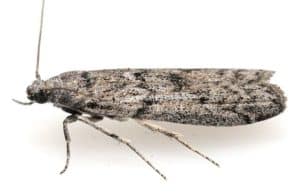Moth Pest Control Services

An established moth infestation usually requires professional treatment to completely solve the problem. Although many homeowners attempt the “do it yourself” measures for moth control – the results are often disappointing.
The #1 most popular moth problem is Pantry Moths
Have you ever noticed weird clumps in an old bag of flour, webbing along the corners or edges of food packaging, or rice that appears to have cobwebs? If the answer is yes, you’ve seen pantry moths. The term ‘pantry moth’ usually refers to the Indianmeal moth.
While there are numerous different types of moths, the Indianmeal moth is the most common household pantry pest in the USA. It is different from other types of moths because it is attracted to stored food, unlike the clothes moth which is attracted to clothing.
As with most living creatures, pantry moths only objective is to reproduce. Moths infest places with an adequate food supply. This gives them a place to lay their eggs while giving their offspring the best chance of survival.
Moths can enter your home through open doors and windows. They may also enter through cracks around dryer vents, utility chases, or cables that pass through walls. It is shocking when you open a sealed cereal box only to find evidence of pantry moths inside. You may not notice them until they have already passed through the different phases of a pantry moth life cycle and you see an adult moth flying around your home.
The Pantry Moth Life Cycle
There are four stages in the life cycle of a pantry moth:
- Egg: Moth eggs are extremely tiny and whitish-grey in color. An adult can lay approximately 400 eggs at a time, and they can hatch in just 7 days.
- Larva: This is the stage that causes damage. Moth larvae are tiny worm-like eating machines. The casings they leave behind will contaminate food, making it unusable. The larval stage typically lasts 2-3 months depending on conditions.
- Pupa: Moths in the pupal stage are in cocoons, usually hidden in cracks, corners, or crevices. Often identified by the cocoons buried underneath food, causing the matted webs. Moths usually take 15-20 days to develop from pupae into adults.
- Adult: The adults appear fully winged, they are attracted to light and fly around looking to reproduce. Interestingly enough they do not have working mouthparts and cannot eat. This means their sole objective is to reproduce.
MOTH CONTROL MEASURES
Prior to recommending a moth control solution, your Pest Control Tech will properly identify the moth species affecting your property. Different moth pest species require different treatment methods to effectively control them.
All factors need to be considered when trying to devise a strategy to eliminate the moths. These factors can include; species, stored products, type of structure, etc.
Control measures for stored products moths (Indian Meal Moths, Mediterranean flour moth, etc.) include going through all of the pantry items and throwing away all open grain-type products, better storage containers, freezing existing packages to kill eggs, and spraying the closet to eliminate the problem. However, for the fabric moth pests; vacuuming the entire closet including the walls, throwing away any paper items that could be harboring eggs, proper storage, and application of pesticides. Monitoring using various traps including pheromone traps where applicable is done thereafter to ensure moth problems do not continue.
All our State certified technicians are highly-skilled and are required to participate in regular continuing education programs to keep them up-to-date with industry standards.
Call us (678)935-5900
